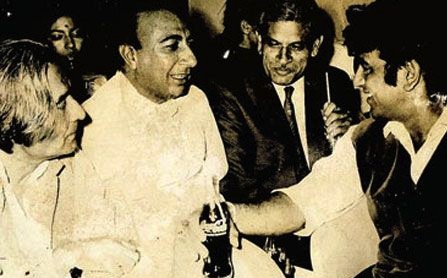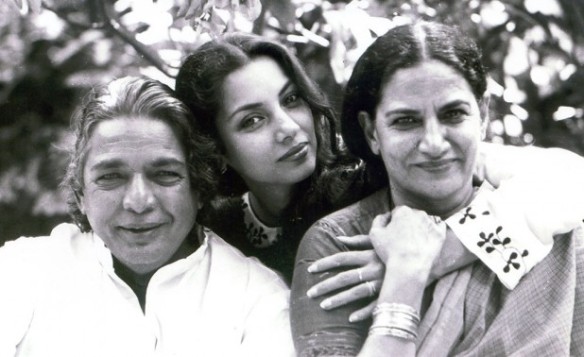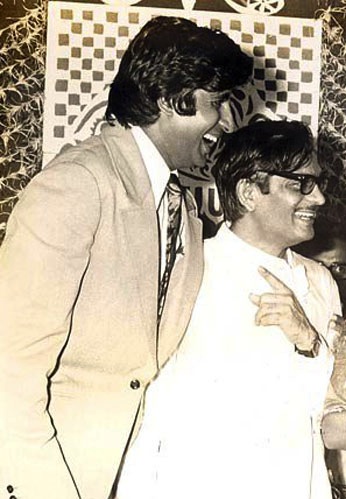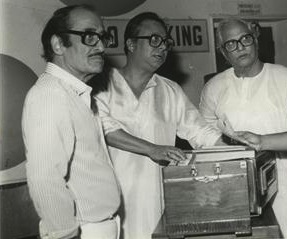
Legendary Bollywood lyricists Jan Nisar Akhtar (far left) and Sahir Ludhianvi (left center) enjoy a birthday celebration.
The language of Hindi films has evolved since the first talkie Alam Ara in 1931, based on a Parsi play. The Golden Age of Hindi cinema that blossomed with the studio era of the 1950s and ebbed by the late 1970s is one of India’s greatest artistic achievements. During that time, Hindi films could hardly be called Hindi films. Rather, Hindustani, a mixture of Urdu and Hindi, was the lingua franca of the silver-screen—a reflection of a country unified by a fascinatingly diverse heritage with linguistic influences from Sanskrit, Farsi, Bengali, Arabic, Panjabi, and a myriad of others.
To anyone unfamiliar with the distinction between Urdu and Hindi—there are no hard and fast rules. What many call Hindi, others would call Urdu, but most everyone can appreciate their structural and grammatical similarity. Any attempt to divide them is based on the root origins of the vocabulary intermingled with what is generally a highly homologous syntax. “Urdu” vocabulary tends to draw upon words of Farsi or occasionally Arabic and Turkish origin and “Hindi” vocabulary is generally derived from Sanskrit or regional dialects. But don’t be fooled into thinking any word “belongs” to another language (or those of a particular religion)—Hindustani may vary speaker to speaker, community to community, but the language is all-encompassing.

Veteran Urdu poet Kaifi Azmi (left) with his daughter actress Shabhana Azmi (center), who married contemporary lyricist Javed Akhtar, and wife Shaukat Azmi (right).
The impact of Urdu in the Indian mainstream can be no better summed up by the famous words of our freedom struggle: “Inquilaab zindabaad!” or “Sarfaroshii kii tamanna ab hamaare dil mei.N hai.” Controversial arguments have been made relating the decline in popularity to links with Pakistan, which adopted Urdu as its official language. Yet in Hindi films for decades, the legacy of Urdu poetry continued to flourish in India as the pinnacle of culture and expression.
Indeed, despite enormous gaps in literacy across the country, some of the most popular songs of that era amazingly contain the most complex Urdu-based vocabulary. Perhaps one reason is that the Hindi film song-writers themselves were trained in the art of Urdu poetry. Many of the finest and most successful poets of Hindi film: Sahir Ludhianvi, Raja Mehdi Ali Khan, Gulzar, Hasrat Jaipuri, Shakeel Badayuni, Kaifi Azmi, Jan Nisar Akhtar, and Majrooh Sultanpuri to name but a few, began their careers in Urdu mushairaas, or poetic symposiums.

Record-breaking winner of 11 Filmfare awards for best lyrics, poet Gulzar (right) stands with actor Amitabh Bacchan (left) for whom he wrote hits from the dialogue of Anand (1971) to the modern dance number “Kajra Re” from Bunty Aur Babli (2006)
It would seem more than mere coincidence that these artists came to dominate film lyrics. Like many arenas, the Bombay film industry was an old boy network: Sahir Ludhianvi for example was close friends with Jan Nisar Akhtar, who became in-laws with Kaifi Azmi, who was a prominent member of the pre-partition Progressive Writer’s Movement with Majrooh Sultanpuri. And the music directors who often hand-picked their lyricists and made recommendations to film producers were also steeped in similar artistic traditions. Veteran composer Naushad grew up in the heart of Lucknowi culture, and Madan Mohan spent his childhood in the Middle East, eventually getting his break by joining the All India Radio in Lucknow. Yet connections in the film industry account for only part of its success—audiences had to maintain demand as well.
From the epic qawwali “Yeh Ishq Ishq Hai” from Barsaat Ki Raat (1961), the lilting ode, “Aap Ki Nazron Mein Samjha” from Anpadh 1962), to the playful duet “Deewana Hua Badal” from Kashmir Ki Kali (1964), Urdu in films was remarkably accessible—holding a place for any viewer in every genre. True, it is unlikely the entire audience understood each word in those songs. However, in this manner, film and music could be educational for those who did not–a unique way of preserving the culture they reflected back on. As parallel cinema diva Shabana Azmi aptly quipped,
“If you compare today’s songs with the songs of the 1960s and 1970s, then definitely today’s songs are according to the demand. But if you see, Hindi films used to protect the Urdu language as they used it, but it is slowly dying and I feel bad for it.”
The same extended to the dialogues of films themselves–and I don’t refer only to genre films like Pakeezah (1971) or Mughal-e-Azam (1961). Pure Urdu was ubiquitous in classic Hindi cinema, wafting equally through the sets of an urban crime drama and meandering through a village epic. The importance and sheer beauty of Urdu poetry in dialogues is highlighted in one of the most famous film speech’s of yesteryear. The stirring climax of Daag (1973) culminates in a speech given by Rajesh Khanna’s character for an award bestowed to him by his community. Notice how in this and so many other scripts, Urdu is an inextricable poetic catalyst for the Hindi speech:
Rajesh Khanna’s Speech from Daag (1973):
“Aap.
Aap kya jaane mujhko samajhte hai.N kyaa?
Mai.N to kuch bhi nahii.N
“You.
I do not know what you make of me
For I am nothing
Is qadar pyaar itnii baDe bheed ka mai.N rakhuu.Ngaa kya?
Is qadar pyaar rakhne ke qaabil nahii.N
Mera dil, merii jaan…
Mujhko itni mohabbat na do, dosto.
Soch lo dosto…
Is qadar pyaar kaise sambhaaluu.Ngaa mai.N?
Mai.N to kuch bhi nahii.N
How can I carry such love from so great a crowd?
I am not worthy of such great love
My heart, my life…
Do not give me so much love, my friends
Think instead.
How will I bear such great love?
For I am nothing.
Pyaar.
Pyaar ek shakhs ko agar mil sake to badii cheez hai zindagi ke liye
Aadmi ko magar yeh bhi milta nahii.n
Yeh bhi milta nahii.n
Mujhko itni mohabbat milii aap se,
Mujhko itni mohabbat milii aap se…
Yeh mera haq nahii.N, merii taqdiir hai.
Mai.N zamaane ki nazro.N mei.N kuch bhi na thaa.
Merii ankho.N mei.N ab tak woh tasveer hai
Love.
If a man can receive love, it is a great thing in life
Yet many men do not even receive this
They do not even receive this
I have received so much love from you,
I have received so much love from you
This is not my right, it is my fate
I was once nothing in the eyes of the world
And in my eyes, that image remains
Izzate.N, shauharate.N, chaahate.N, ulfate.N, koi cheez duniya mei.N rehtii nahii.N
Aaj mai.N huu.N jahaa.N, kal koi aur thaa.
Yeh bhi ek daur hai, woh bhi ek daur thaa…
Respect, fame, desire, love, nothing remains in the world permanently
Today where I am, yesterday there was someone else
This is one generation, that was another generation…
Aaj itni mohabbat na do dosto.
Ki mere kal kii khatir ka kuch bhi rahe
Aaj ka pyaar thoDa bacha kar rakho
Aaj ka pyaar thoDa bacha kar rakho, mere kal ke liye
Today do not give me so much love, my friends
So that there may be some left for me tomorrow
Today, save some of that love
Today save some of that love for my days ahead
Kal.
Kal jo gumnaam hai
Kal jo sunsaan hai
Kal jo anjaan hai
Kal jo viiraan hai
Tomorrow.
Tomorrow which is anonymous
Tomorrow which is silent
Tomorrow which is unknown
Tomorrow which may be barren
Main to kuch bhi nahii.N huu.N
Mai.N to kuch bhi nahii.n”
I am nothing at all
I am nothing at all.”
With every thoughtfully chosen word, the pervasive Urdu “qaaf” is pronounced as delicately as the gentle “khe,” and the lines are delivered with the poetic overtures of a song lyric. These dialogues were written with poetry in mind, and indeed many song lyricists eventually took to writing entire film scripts (the script of Daag was written by immortal Urdu poet Akhtar ul Iman of Waqt and Gumraah fame).

Famed lyricist Majrooh Sultanpuri (right) with music director R.D. Burman (center) and film director Nasir Hussain (left) at a 1983 recording session.
It would be impossible to summarize the incredible work of these poets in one post (hence why we’ve devoted much of our blog to it!). A small sampling of Filmfare award-winning lyrics are below:
“Chaudhvin ka chaand ho, ya aftaab ho? Jo bhi ho tum khudaa ki qasam laa-jawaab ho…” –Shakeel Badayuni (Chaudhvin Ka Chand 1961)
“Chaahuu.Ngaa mai.N tujhe saa.Nj saveN.re. Phir bhi kabhi ab naam ko tere awaaz mai.N na doo.Ngaa…”--Majrooh Sultanpuri (Dosti 1965)
“Bahaaro.N phool barsaao, meraa mehboob aayaa hai. Hawaao.N raagini gaao, meraa mehboob aaya hai…”--Hasrat Jaipuri (Suraj 1967)
“Kabhi kabhi mere dil mei.N khayaal aataa hai ki jaise tujhko baanaayaa gaya hai mere liye…” –Sahir Ludhianvi (Kabhi Kabhi 1977)
“Aanewaalaa pal jaanewaalaa hai. Ho sake to is mei.N zindagii biTaado pal jo yeh jaanewalaa hai…” — Gulzar (Gol Maal 1980)
I was fortunate to have the chance to learn to read and write in Urdu from my grandparents who moved to New Delhi after the partition of Punjab. But this opportunity is so rare that I found after my grandfather passed away, I know few people to whom I can still write in Nasta’liq. Urdu is a language of romance—more beautiful than French and Italian, and more intricate than superficial political divides. The legacy of Urdu will continue to add to the allure and nostalgia of old films for generations to come. For the loss of Urdu is more than the mere loss of vocabulary. Without Urdu in Hindi films, we have lost our own andaaz–the manner with which we once communicated our thoughts and feelings, our decorum, and a rich, meaningful ornamentation in expressing ourselves that can never be replaced.
-Mrs. 55

What a beautiful essay! You wrote about a poetic language in poetic prose!
You mentioned that “Controversial arguments have been made relating the decline in popularity to links with Pakistan, which adopted Urdu as its official language.” I would like to know a bit more in detail how the attitude towards Urdu and reception to Urdu has changed over time since the partition. If you were a Bollywood film director, would you have done more than the other directors to attempt to preserve the Urdu language in Indian cinema?
Thank you for the comments! A large controversy does exist over the place of Urdu in formal education. Although Indians in pre-partition Panjab were taught to read and write Urdu in schools, this was not the case after partition–despite a heritage that had benefited from it. Much of this was of course related to feelings of more than ill-will from the partition. But that is not to say that Urdu suddenly vanished from India, although perhaps so from the textbooks. Urdu continued and continues to be taught and spoken across the continent–from Kashmir to Hyderabad.
And to answer your excellent second question, yes!! I think Urdu has an importance place culturally in films and even in my thesis film at Harvard, I wrote the climax dialogue with the most eloquent Urdu poetry I could muster! 🙂
I saw the movie directed by Ismail Merchant – In Custody/Muhafiz (1993) that sums up what happened to Urdu language in India after partition.
What an amazing blog!!!!!!
Haha thank you for reading!
So eloquent, fascinating, interesting and intelligent. Thank you so much and look forward to hearing from you in the future,
Rajnish Sharma
We’re glad you enjoyed!
Just love that dialog from Daag which seems to have been a favorite of Rajesh Khanna who always used it in his speeches and his magical voice made it more beautiful.
A bit surprised you did not mention Pyaasa which has Sahir’s immortal poetry ‘Ye Duniya agar mil bhi jaye to kya hai’ !
It’s definitely true–Rajesh Khanna speaking poetry is more than anyone could ever ask for! And the poetry of Pyaasa is incomparable–in particular, that scene is an excellent example of the blur between lyrics and dialogue in film! Guru Dutt had always very deliberately tried to make his songs extensions of the dialogue itself. The list of beautiful poems from classic films is simply innumerable 🙂
What a wonderful piece this is, thank you so much! Here is a link to the full audio of the ‘Daag’ piece by Kaka in his inimitable voice.
Thank you for sharing this link!
If you haven’t seen it before, here is the link to Balraj Sahni’s convocation address of 1972 in JNU (Jawaharlal Nehru University, Delhi). Very interesting but in the context of your excellent post on the subject, his thoughts on Hindi-Urdu, Hindustani, and a ‘rashtriya bhasha’ where ‘ladka bhi jata hei’ aur ‘ladki bhi jata hei’!
http://www.outlookindia.com/article.aspx?266141
Great article, and Suhan, thank you so much for pointing to the convocation address link. Brilliant people and the themes that they spoke of so evocatively, still hold true.
Pingback: The Immortal Dialogue of Pakeezah and English Translation | Mr. & Mrs. 55 - Classic Bollywood Revisited!
Pingback: Yeh Ishq Ishq Hai Lyrics and Translation: Let’s Learn Urdu-Hindi | Mr. & Mrs. 55 - Classic Bollywood Revisited!
Pingback: Hindi Film Songs with Unnecessary English: Fusion Lyrics in Old Bollywood | Mr. & Mrs. 55 - Classic Bollywood Revisited!
Pingback: Yeh Duniya Yeh Mehfil Lyrics and Translation: Let’s Learn Urdu-Hindi | Mr. & Mrs. 55 - Classic Bollywood Revisited!
I stumbled on this blog by accident! What a serendipitous discovery!
Pingback: Kar Chale Hum Fida Lyrics and Translation: Let’s Learn Urdu-Hindi | Mr. & Mrs. 55 - Classic Bollywood Revisited!